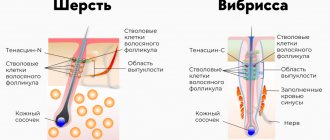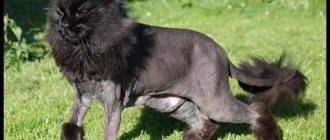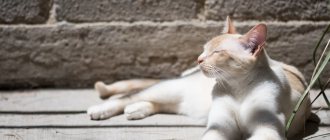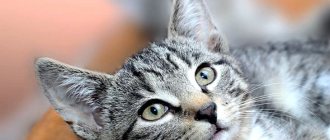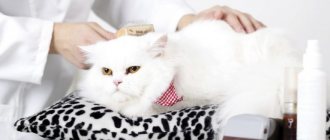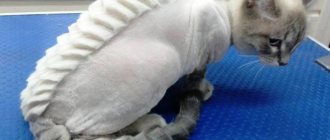Grooming cats will help keep their coat well-groomed in winter and summer. The procedure can be performed at home or in a salon or veterinary clinic. Fashionable hairstyles will allow you to brightly present your pet at an exhibition, and hygienic grooming will get rid of tangles and refresh the aesthetic appearance of the cat. To get a haircut correctly and safely, you need to know the rules and types of hairdressing services.
How often do cats get their hair cut?
Grooming of Scottish cats, British Fold cats, Siamese and other smooth-haired cats is not regular and mandatory; it is performed either for medical purposes (preparation for surgery or ultrasound diagnostics) or for an exhibition (artistic grooming). Grooming cats with semi-long fur is harmful if done more than twice a year. We must remember that hairstyle gives the animal not only stress from the process, but also discomfort in everyday life, since the pet feels the temperature differently, feeling “undressed”. Grooming short-haired pets is harmful and not recommended.
What should you know before grooming your cat?
Before taking your baby to professional stylists, you need to familiarize yourself with several important rules: 1) If the cat is about to have an exhibition, then a haircut can be done no later than 6 months before this event. In addition, show animals cannot be cut bald. 2) The grooming procedure largely depends on the character and temperament of your pet. Anxious cats are often given muscle relaxants for a calm, simple, stress-free grooming experience. 3) Sometimes haircuts cause changes in the color and structure of the fur. However, in practice this happens very rarely. 4) The speed of hair restoration in cats varies from person to person. Some pets cannot regain their original fur length for many months. 5) Professionals are sure that during a haircut you should not touch the hair on the face, head and ears.
Who is doing?
Decoration from animal fur can only be done by an experienced specialist in this matter.
Depending on the purpose of the haircut, it can be performed in different places. A veterinarian will trim the mats. The procedure is common in veterinary clinics, but it is also performed by a cat groomer in a salon. Complex types of artistic hairstyles and work with dense, long and thick fur, cutting Siberian, Norwegian and Persian cats is done only in zoo hairdressers. Decorative haircuts for cats should be performed by a groomer; it is better not to try to cut your pet’s hair artistically on your own - the cost of a mistake is too high.
Animals cannot be groomed with a regular human machine. It is permissible for people to trim a cat using hairdressing equipment in an emergency and provided that the trimmer has at least 30 watts of power and the blades are ultra-sharp.
Is it possible to cut a cat's hair yourself?
Each cat owner can independently decide on the haircut of their pet, as well as do the haircut themselves. However, you should not underestimate the complexity of such a procedure; you must act carefully so as not to harm your pet. If you are not confident in your abilities or suspect that the pussy will negatively perceive independent attempts to cut it, it is better to contact professionals, they will be able to do everything quickly and safely for the pet. If you are confident in your abilities, then you first need to choose a haircut that suits your pet. This is easy to do on the Internet, where not only a huge database of photographs with various haircuts has been collected, but also practical recommendations for performing each of them are offered. After choosing a suitable haircut, you need to purchase and prepare the necessary tools for this. Most often for a haircut you need:
1) Table or ironing board. 2) Machine with a 3 mm nozzle. 3) Comb. 4) Scissors. 5) Hydrogen peroxide or iodine - for treating wounds if they cannot be avoided. It is not recommended to try to do the work yourself; cats usually react negatively to attempts to strip them of their fur, so you will definitely need someone's help.
The assistant will have to hold the cat on the table, holding it by its hind and front legs. Do not squeeze too hard to avoid harming the cat. Initially, hair should be removed from the sides, belly and back. You need to be especially careful when cutting intimate areas, armpits and nipples.
You can't start cutting without a clipper. You cannot cut your pet's hair efficiently, safely and effectively with scissors; in addition, they can very easily damage the cat's skin and cause harm to it, which will lead to the need to contact a veterinarian.
Haircut options
The initial reason why the cat decided to correct the appearance of her fur coat dictates the choice of the type of grooming. According to purpose, cat grooming is divided into the following types:
- hygienic;
- medical;
- artistic (modeling, decorative hairstyles).
Hygienic
This method is used if the animal has accumulated a lot of tangles and they cannot be combed out.
When combing cats no longer saves them from tangles, a hygienic haircut will help rid the animal of clumps of stray hair. Regular trimming of caked fur is not difficult; you can trim a long-haired kitten or an adult cat yourself at home if you have the appropriate tools and minimal skills. The degree of hygienic grooming varies: if there are numerous lumps, cats are cut bald; if the coat is not very matted, problem areas with tangles are simply shaved off.
Model
Unusual fashionable options for the design of fur are made for pets for exhibitions, photo shoots, and just “for fun.” You can choose creative cat haircuts by visiting a pet salon. The traditional model treatment of the Persian and fluffy red cats as a lion is good. Semi-long white kittens are decorated in the style of teddy bears. The white purr is also cut to look like a poodle. Professional artistic grooming of Angora cats, fluffy Persians, British, Scottish and exotic cats should be performed exclusively by a master.
Features of haircuts and why they are needed
Only at first glance it seems that grooming cats is solely a whim of the owners. In fact, it is essential to keeping your pet in excellent health. Stray hair can cause a cat significant discomfort and even cause severe pain. As a result, the animal will become irritable and nervous, will stop allowing itself to be stroked, and will not seek the attention of its owners. And, of course, a haircut makes the cat more attractive, funny and interesting.
- Why you need to cut your hair - the main reasons
- How often should you cut your pet's hair?
- What should you know before cutting your hair?
- Types of cat haircuts
- Home haircut
- Model haircut
- Is it possible to cut your pet's hair yourself?
General rules
You can work with the hair of some animal breeds with scissors.
To be safe, new haircuts for cats are done according to certain standards and recommendations. you should know who and how you can groom. It is allowed to cut a Persian cat and a pet with another long-haired breed using scissors, a mechanical hand or an electric machine. A Scotsman or a Briton can only be groomed with a machine, and scissors cannot be used to work with the hair of a Siamese cat. At the end of the process, the animal is bathed in warm water to remove small clipped hairs.
After the haircut, the cat should receive positive emotions in the form of a soothing, gentle stroking and tasty treats - this way the fright will go away faster. If the pet is shaved bald, the discomfort and anxiety will subside when the cat grows new fur 3-5 mm long, so that the animal does not attack its own tail, not perceiving it as its own, a brush is always left at the end.
Safety of the procedure
The absence of injuries is one of the main criteria for professional work. The fur is usually removed against the grain, but shaving the pet’s coat in the opposite direction is also acceptable, especially if these are small kittens or nervous adult purrs. Grooming according to hair growth makes it possible to avoid causing additional discomfort and stress to the animal. Before treatment with a machine, the tummy is carefully trimmed with scissors, paying special attention to the nipple area so as not to damage them.
A special collar is necessary for animals that are prone to nervousness and aggression during grooming.
If the animal is nervous, put on a collar and groom without anesthesia. A pet wearing a collar does not see what is happening and is less nervous; besides, this way it will not be able to bite the hairdresser. Particularly aggressive patients are groomed with immobilization - the master's assistant firmly holds the cat by the paws and head, not allowing him to twitch and interfere with the process. If there are a large number of mats and it is necessary to completely cut off the fur, the “aggressor” must be groomed under anesthesia.
Why do they cut their hair - the main reasons
The main reason why many owners cut their pets' hair is mats. They can have an extremely negative impact on the health and well-being of a cat: 1) Lost hair tightens the skin, causes pain and causes constant discomfort. A cat in such a situation will react especially negatively to attempts to pet it. 2) Tangles disrupt blood flow in places where the skin is tightened and also negatively affect heat exchange. Such conditions are perfect for the proliferation of pathogens. 3) In places where tangles occur, the skin often becomes inflamed, peels and itches, causing discomfort to the pet. 4) Cats often try to get rid of tangles on their own, but due to the impossibility of using special tools, the pet may inadvertently injure itself. 5) The pet’s attempts to get rid of the problem often lead to the ingestion of a large amount of fur, which in turn can cause vomiting, as well as blockage of the digestive system. Because of this, owners will have to seek help from a veterinarian, since only a specialist can solve such a problem.
Grooming is also required during shedding, during which the cat also eats a lot of fur and becomes less attractive. Older cats often stop caring for their fur as carefully as they did when they were young, which is why they especially need help from their owners in dealing with problem areas and tangles.
IMPORTANT! Regular grooming reduces the amount of hair your cat ingests during daily grooming. This has a positive effect on the pet’s digestive system and its overall health.
Grooming is also recommended in cases of cat skin diseases and severe allergies to wool in humans.
What happens if a cat's whiskers are cut off?
If you trim a cat's whiskers, he won't feel pain - just like we don't feel it when we trim our hair and nails. However, a cat without whiskers will be less able to navigate in space, especially in the dark.
Interesting materials:
When can broilers be given whey? When can broilers be left overnight? When can debt collectors call? When can baby rats be separated from their mother? When can babies be seated? When can a credit card be refused? When can inspections be carried out by the prosecutor's office? When can there be a draw in chess? When can you pick up small kittens? When can you take holy water?
What time of year do cats get their hair cut?
Attention! Pets that do not go outside can be groomed, regardless of the time of year. Animals that constantly run outdoors are usually trimmed before the onset of the summer heat.
It is customary to care for the fur of British cats without haircuts.
This will make it easier for cats to tolerate the heat, and by the beginning of the autumn cold weather, the fur will grow to the desired size and will be able to protect the animal from the cold.
Useful tips
To cut your cat's hair yourself, you need to know the subtleties:
- You cannot cut the hair on the cat’s head, on the pads, in the ears, or shorten the whiskers. Cut hair on a pet's head can disrupt its spatial orientation. The fur in the ears performs a protective function against the penetration of dust and foreign bodies.
- Sometimes after a haircut, the coat changes structure and shade. It may become darker or lighter.
- Please note that the length of the regrown coat may be shorter than the previous one.
- The haircut process is quite long and labor-intensive. If you do not have such experience, you should expect 2-3 hours.
- It is recommended to use the machine on dry skin. When using scissors, the fur is slightly moistened and combed, then it will be easier to deal with vegetation.
- Cats should not be cut too short. A few millimeters should remain to maintain natural thermoregulation and avoid skin damage.
- The owner shouldn't worry. His condition is transmitted to the animal and can easily provoke stress. The cat will begin to struggle and scratch.
- Nervous animals are easier to trim their fur. The hair will remain longer and the cat will worry less. Haircut against the grain greatly irritates your pet.
- To alleviate nervousness, it is recommended to cut your hair in several approaches. During breaks, stroke and soothe in every possible way.
- Cats have a hard time reacting to outbursts of emotion during or after grooming. This should be avoided and not made fun of by the haircut.
Grooming cost
- In Moscow, cat grooming costs from 1100-1200 rubles and more.
- In St. Petersburg - from 1600 to 1800 rubles, depending on the size of the animal.
- The cost of grooming in Yekaterinburg is 1000-1200 rubles.
- In Lipetsk you can cut a cat's hair for 1,500 rubles.
- In Chelyabinsk, the cost of a standard haircut is from 1 thousand rubles.
- In Novosibirsk, groomer services will cost 1,500 rubles and more.
- In Krasnoyarsk - from 1400 rubles.
- In Khabarovsk, cat grooming costs from 1,500 rubles.
The cost of additional services (combing or trimming tangles, shortening nails, treating ears and eyes) also varies depending on the region.
Most salons provide discounts to regular customers.
Is it possible to shave a cat or why does a cat need fur?
Is it possible to shave a cat: why does it need fur and is it harmful to cut it, is it possible to get rid of fleas this way and how to shave it correctly at home.
Why does a cat need fur?
A cat's fur coat performs several important functions: - warms it up in cold weather; - protects from wind; - protects from sun rays in summer; - protects the cat in fights.
Is it possible to shave a cat
For indoor cats, fur does not play the same important role that it plays for outdoor cats, since they do not need to worry about heating or protecting their skin from being scratched by opponents. It follows that you can shave a cat , but if there is no urgent need for it, then it is not necessary , because, in general, it will not bring her any benefit. Even fluffy cats practically do not suffer from the heat, since they have excellent thermoregulation, which can only be disrupted by haircuts.
Just like a trimmed mustache, the cat's fur will grow back. After it is restored, its , pattern, length, and density will not change The new coat will be exactly the same as before.
You should not hope that a shaved cat will not shed . Her growing fur will fall out with exactly the same frequency as if she were unshaven, and only the length of the hairs will be shorter.
Shave for fleas
This is not a good idea. By shaving a cat, it is impossible to rid it of fleas , since it is only a source of food, and fleas do not live in its fur permanently. Fleas live and breed on bedding and other convenient places, so they will bite a shaved cat in the same way as an unshaven one.
How to trim or shave a cat at home
Doing this on your own is very difficult and the result, at least the first time, will not be what you expect. The main problem is that the cat is constantly moving, there are many depressions and bulges on its body, it does not like when someone turns it over and touches its stomach or brings something cutting to its neck, and, besides, all cats have There are eight nipples each that need to be avoided while shaving. At home, you can only trim or shave a very calm animal , which under normal conditions allows its belly to be stroked and is distinguished by a certain degree of indifference to what people do to it.
What is grooming
What is grooming? This is a cat grooming and additional procedures, the purpose of which is to improve the appearance, condition of the skin and coat of your pet. This result is obtained by ridding the cat of excess hair, removing dead hairs.
There are three types of grooming: hygienic, home and exhibition, otherwise called model grooming.
Hygienic grooming is the most practical option for this procedure. As the name implies, this type of grooming is used to ensure that the cat looks clean and tidy, does not leave fur on the carpets and furniture during the molting period and does not clog its stomach with it.
During this procedure, the cat's fur is trimmed evenly, the tips of the claws are removed using a special tool - a nail cutter, long tufts of hair on the paws are shortened, and the ears are tidied up.
Home grooming is the most budget-friendly, but also the simplest option: cat grooming, which is often mastered by cat owners themselves. It consists of shortening the pet's fur, which becomes much easier to care for.
Exhibition (model) grooming is a set of procedures that serve to emphasize the advantages and reduce the external disadvantages of animals that will participate in the exhibition.
Popular model cat haircuts
- A lion. To give the cat a resemblance to the king of beasts, his back, belly, paws to the “socks” and tail to the tassel are cut short. Quite often, a lion haircut is used as a hygienic haircut.
- Puma. This haircut differs from the “lion” haircut in that the animal’s chest is not cut. One of the varieties is “sheepskin coat”.
- The Dragon. The resemblance to this mythical creature is achieved due to the fur left along the line of the back and on the tail. “Steps” are additionally cut from strips of wool on the back and tail.


